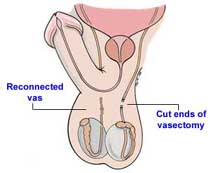
 |
 |
Vasectomy Reversal ProcedureDr. Benderev performs only Vasectomies andno longer performs Vasectomy Reversals. |
 |
|||||||||||||||
IntroductionOf the approximately 500,000 men who choose to have a vasectomy in the United States each year, up to 5% choose to reverse the vasectomy later. The reasons for vasectomy reversals include:
Background Background
Occasionally, the original vasectomy has caused a blowout of the epididymis, a tube upstream from the blocked end of the vas deferens. In this case, a standard vasectomy reversal cannot be performed. Instead, the surgeon must connect the vas end to the epididymis even further upstream from the blowout. This more complicated procedure is called an "Epididymovasostomy". The Vasectomy Reversal ProcedureThe detailed work of a "Vasovasostomy" or "Epididymovasostomy" is usually peformed using magnification to adequately visualize and suture the vas and even smaller epididymis. The microsurgical technique of reconnecting the tubes is frequently performed with multiple layers of fine suture that are smaller than human hairs. A general or spinal anesthetic is usually used. The procedure can be performed on an out-patient basis with the patient returning home the same day as the procedure. Success RatesThe success rate of a vasectomy reversal depends on the
There are clues before and during surgery to help predict the quality of the tissues and thereby the chances for success. During SurgeryAn important predictor of success is the quality of the fluid coming from the vas end at the vasectomy site. If the surgeon finds fluid with sperm cells coming from the vas, he or she can generally build an open channel by reconnecting the vas ends in greater than 90% of patients. The actual pregnancy rate, though, is less because the actual sperm may no longer be able to complete the process of fertilization. Nevertheless, pregnancies can result in greater than 60% of such cases. If only fluid without sperm can be seen coming from the vas end, the surgeon can build an open channel through the vasectomy site in somewhat greater than 50% of patients. The actual pregnancy rate is frequently closer to 40%. If the fluid is poor, the vas can be directly connected to the epididymis ("epididymovasostomy") and there is a further reduction in the success rate. Before SurgeryWe can look at the time between the original vasectomy and the time of the vasectomy reversal to predict the success of the vasectomy reversal. In general, men who are less than 10 years out from their vasectomy have a better chance of success. A study of over 1000 patients by multiple vasectomy reversal surgeons - the Vasectomy Reversal Study Group* - reported the following results:
* Belker AM, et al. Results of 1,469 microsurgical vasectomy reversals by the Vasovasostomy Study Group. Journal of Urology 1991; 145(3):505-11.
|
||||||||||||||||
Check out Theodore Benderev, MD on Yelp | ||||||||||||||||
| Home | No-Needle, No-Scalpel Vasectomy | Anatomy & Terms | Risks & Complications | Alternatives | What to Expect | Vasectomy Procedure | Vasectomy Reversal | Dr. Benderev | Request an Appointment | Contact Us |
Site content copyright © 1999-2025 Theodore V. Benderev, M.D. All Rights Reserved. 1-888-VASECTOMY (888-827-3286) Notice of Privacy Practices The content of this site is provided for information only and not for medical advice. This site makes no claims as to the accuracy of its information and is not a substitute for direct consultation with your health care professional. Dr. Ted Benderev is a well known urologist since the1990's who has performed more than 15,000 vasectomy and vasectomy reversal procedures. His practice is conveniently located in the Orange County communities including Aliso Viejo, Anaheim, Costa Mesa, Corona, Fountain Valley, Fullerton, Huntington Beach, Irvine, Ladera Ranch, Laguna Hills, Laguna Niguel, Mission Viejo, Newport Beach, Orange, Rancho Santa Margarita, San Juan Capistrano, Santa Ana, San Clemente, Tustin, Westminster, and adjacent Inland Empire counties of Riverside and San Bernardino, San Diego and Los Angeles. |
 The technical name for a vasectomy reversal is a "Vasovasostomy." This is surgically performed by reconnecting the previously cut ends of the vas deferens to rebuild an open vas channel (see illustration).
The technical name for a vasectomy reversal is a "Vasovasostomy." This is surgically performed by reconnecting the previously cut ends of the vas deferens to rebuild an open vas channel (see illustration).